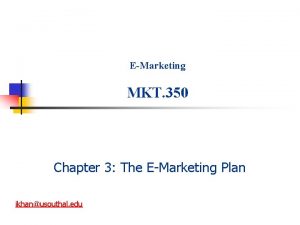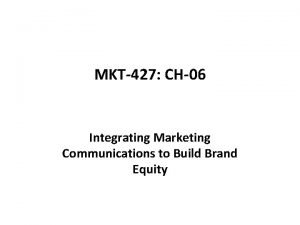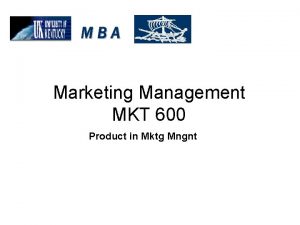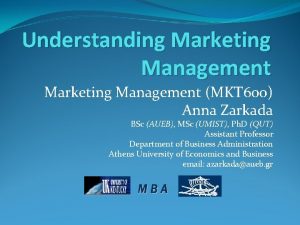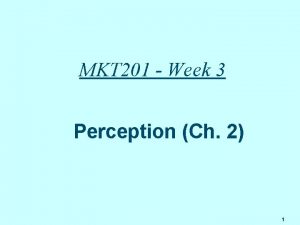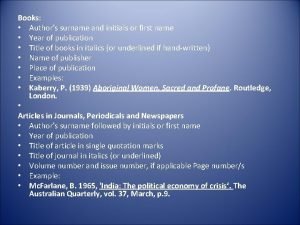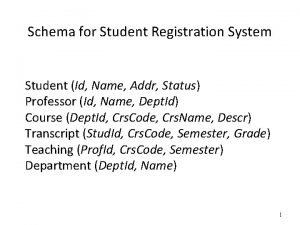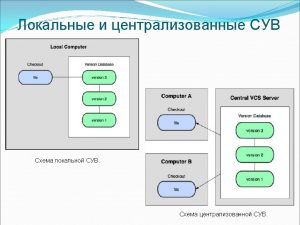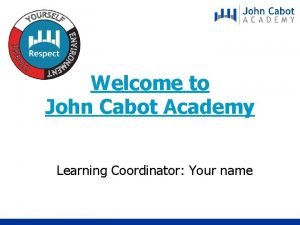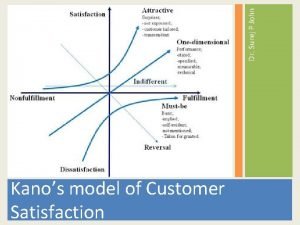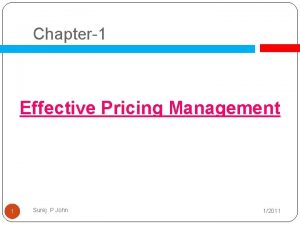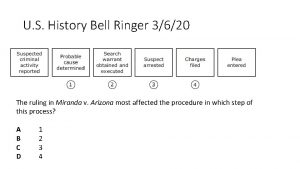MKT 3620 1 1 Name Surej P John










































- Slides: 42

MKT 3620 1 -1

Name: Surej P John Office: MSM 3 rd floor, Cabin# 01 Email: surejpjohn@gmail. com Website: http: //surejpjohn. hpage. com/

CHAPTERS & TOPICS TO BE DISCUSSED Chapter 1: Introduction to Global Marketing Chapter 2: The Global Economic Environment Chapter 3: Regional Market Characteristics and Preferential Trade Agreements Chapter 4: Social and Cultural Environments Chapter 5: The Political, Legal and Regulatory Environments QUIZ I *** (Chapter 1 – 5) Chapter 7: Segmentation, Targeting, and Positioning Chapter 8: Importing, Exporting, and Sourcing Chapter 9: Global Market Entry Strategies: Licensing, Investment, and Strategic Alliances Review for Midterm / Term Project Checking (1 st Half) Midterm Examination *** (Chapter 1 – 5, 7 – 9) July 19 th, 2011 at 12. 00 -14. 00

Mark Allocations Quizzes (2 x 5%) 10% 5% Class Participation Group Project Group project presentation 30% Midterm Examination Comprehensive Final Examination Total Surej P John 40% 100% 4

Online resources • Course syllabus, project outline, power points are all available in www. lms. au. edu • Enrollment key: MKT 30 • All students are requested to register online to make use of the online resources. 1/ 2010 Surej P John 5

CHAPTER 1 INTRODUCTION TO GLOBAL MARKETING

Introduction Global versus “regular” marketing Scope of activities are outside the home-country market Product/market growth matrix 1 -7

Market Penetration Started the first shop in 2004 In 2009, the number of shops reached 41 including 8 University campuses 8 Surej P John 1/ 2011

Market Development

Product Development 10 Surej P John 1/ 2011

Diversification is developing new products for new markets 11 Surej P John 1/ 2010

Global Marketing Create value for customers by improving benefits or reducing price Improve the product Find new distribution channels Create better communications Cut monetary and non-monetary costs and prices Value = Benefits/Price 1 -12

13 Surej P John 1/ 2010

Globalization is the inexorable integration of markets, nation-states & technologies to a degree never witnessed before— in a way that is enabling: vindividuals, corporations & nation-states to reach around the world farther, faster, deeper & cheaper than ever before, & in a way that is enabling: v the world to reach into individuals, corporations & nation-states farther, faster, deeper & cheaper than ever before. 1 -14

Competitive Advantage and Global Industries Competitive advantage: When a company succeeds in creating more value for customers than its competitors, that company is said to enjoy more competitive advantage Global industry A global industry is one in which competitive advantage can be achieved by integrating and leveraging operations on a world wide OR An industry is global to the extent that a company’s industry 1 -15 position in one country is interdependent with its industry position in another country

Degree of Industrial Globalization 118% 120% 100% 77% 80% 60% 42% 33% 40% 20% 1% 0% 16 Consumer electronics Surej P John Apparel Auto Steel IT/BPO 1/ 2011

Competitive Advantage 17 Surej P John 1/ 2011

Global Marketing: What it is & What it Isn’t? ? ? Single Country Marketing Strategy (Table 1 -2) • Target market strategy • Marketing mix – Product – Price – Promotion – Place (Domestic Marketing activities) p. 43

Global Marketing: What it is & What it Isn’t? ? ? Global Marketing Strategy (GMS) • Global market participation (companies have operations in more than one market) • Marketing mix development – 4 P’s: adapt or standardize? • Concentration of marketing activities. • Coordination of marketing activities. • Integration of competitive moves. (Eg. Lenovo) p. 43 -4

1 -20

Standardization versus Adaptation Globalization (standardization) Developing standardized products marketed worldwide with a standardized marketing mix Essence of mass marketing Global localization (adaptation) Mixing standardization and customization in a way that minimizes costs while maximizing satisfaction Essence of segmentation Think globally, act locally 1 -21

Change in the Slogan of Nike in European market 22 Surej P John 1/ 2011

Standardization versus Adaptation Arabic read right to left Chinese “delicious/happiness” 1 -23 The faces of Coca-Cola around the world

Mc. Donald’s Global Marketing Mix Element Standardization Product Big Mac Promotion Brand name Place Localized Mc. Aloo Tikka potato burger (India) Slang ’Macca’s (Australia) Mak. Do (Philippines) Advertising slogan “I’m Loving It” Mc. Joy magazine, “Hawaii Surfing Hula” promotion (Japan) Free-standing Home delivery (India) Swiss rail system dining cars Price 1 -24 Big Mac is $3. 10 in U. S. and Turkey $5. 21 (Switzerland) $1. 31(China)

In India, there are no Big Macs because the Hindu people don't eat beef. However, they have the Maharaja Mac, which is a Big Mac made of lamb or chicken meat. There is. also a vegetarian burger, the Mc. Aloo Tikki.

MANAGEMENT ORIENTATIONS Management emphasis Focus Marketing strategy Stage one Domestic Stage two International Stage three Multinational Stage four Global Domestic Ethnocentric Polycentric Geocentric Domestic Extension Adaption Extension Structure Domestic International Worldwide area Adaption creation matrix/mixed Domestic Centralized top down Decentralized bottom up Integrated Mainly domestic Host country Lowest cost worldwide Investment policy Domestic used worldwide Mainly in each host country Cross subsidization Performance evaluation Domestic market share Management style Manufacturing stance 26 Against home Each host country market share Worldwide 1/ 2011

MANAGEMENT ORIENTATIONS EPRG FRAMEWORK / n o i t a t n orie c i r t n e oc 1. Ethn ERNATIONAL INT Home country is superior to others Sees only similarities in other countries. Assumes products & practices that succeed at home will be successful everywhere. Leads to a standardized or extension approach. just OT ad N O D untry o c e Hom try!! n u o c t s To Ho p. 52

Domestic going International New true coffee shops at Vientiane, Laos & Shanghai, China

MANAGEMENT ORIENTATIONS EPRG FRAMEWORK / s n o i t a t rien O c i r t n e AL N 2. Polyc O I T A MULTIN Each country is unique. o tr un c ST y HO s i s cu Fo Each subsidiary develops its own unique business & marketing strategies. Leads to a localized or adaptation approach. p. 53

Multi-National Approach • In Polycentric stage, subsidiaries are formed in each market and each subsidiaries operates independent of each other and formulates its own marketing strategies • Separate product lines are formed in each country and these products are modified to meet local needs ( Adaptation) • Sales force in each country is local nationals • Channels of distribution are those traditionally used by each country.

MANAGEMENT ORIENTATIONS EPRG FRAMEWORK n io t a t n e i r entric o c 3. Regio A region is the relevant geographic unit. Ex: NAFTA (North American Free Trade Agreement between: Canada, Mexico & U. S. ) Regional airline serving Malaysia and south-east Asian destinations p. 53

MANAGEMENT ORIENTATIONS EPRG FRAMEWORK NS/ O I T A T IEN R O C I AL R N T O N I E T C A NSN A 4. GEO R T R LO ØEntire world is a potential market. GLOBA ØStrives for integrated global strategies. ØRetains an association with headquarters country HD serves world Markets from U. S. ØPursues serving world markets from a single country or sources globally to focus on select country markets. ØLeads to a combination of extension & adaptation elements. p. 53

DRIVING FORCES AFFECTING GLOBAL INTEGRATION & GLOBAL MARKETGING Multilateral economic agreements Converging market needs & the information revolution Transportation & communication improvements Product development costs p. 56

DRIVING FORCES AFFECTING GLOBAL INTEGRATION & GLOBAL MARKETGING Quality World economic trends Leverage p. 59

Leverage Scale economies. • The global company can take advantage of its greater manufacturing volume to obtain traditional scale advantages within a single factory. • Also, finished products can be produced by combining components manufactured in scaleefficient plants in different countries. • The larger scale of the global company also creates opportunities to improve corporate staff competence and quality.

Leverage Experience transfers A global company can leverage its experience in any market in the world. It can draw on management practices, strategies, products, advertising appeals, or sales or promotional ideas that have been tested in actual markets and apply them in other comparable markets. ABB- 1400 subsidiaries in 140 countries. Very famous for running the operations with the minimum number of staff

Leverage Global strategy. • The global company's greatest single advantage can be its global strategy.

Leverage Resource utilization. A major strength of the global company is its ability to scan the entire world to identify people, money, and raw materials that will enable it to compete most effectively in world markets. This is equally true for established companies and startups. For example, British Biotechnology Group, founded in 1986, raised $60 million from investors in the United States, Japan, and Great Britain. For a global company, it is not problematic if the value of the "home" currency rises or falls dramatically, because for this company there really is no such thing as a home currency.

RESTRAINING FORCES AFFECTING GLOBAL INTEGRATION & GLOBAL MARKETGING Management myopia & Organizational culture Opposition to globalization National controls – (to protect local industries) p. 62

Summary • Global marketing is the process of focusing resources on global marketing opportunities • Goal, to create customer value & competitive advantage by maintaining focus • Three classifications of management orientation: ethnocentric, polycentric, regiocentric, geocentric • Global marketing importance is shaped by a variety of driving & restraining forces

Group Assignment No. 1 • Make a detailed study on the Socio-Economic and Cultural factors of BRIC Nations and submit the assignment as a typewritten report. • All groups has to prepare a short presentation ( not more than 15 mins. ) and one of the groups may be asked to do the presentation in the class!! IT MAY BE ANY OF YOU…. . GOOD LUCK •

Looking Ahead to Chapter 2 The global economic environment 1 -42
 Norma iram 3620
Norma iram 3620 Design mkt
Design mkt Emarketing plan
Emarketing plan Mkt-427
Mkt-427 Core augmented and actual product
Core augmented and actual product Mkt 600
Mkt 600 317 home work
317 home work What does mkt mean
What does mkt mean Mkt 317
Mkt 317 Mkt 201
Mkt 201 Name three lines
Name three lines Valeriaim
Valeriaim Authors by initials
Authors by initials Name above every other name
Name above every other name Hexagon shape names
Hexagon shape names Public string name
Public string name What is his name
What is his name Name of presentation company name
Name of presentation company name Name of presentation company name
Name of presentation company name Name date class
Name date class Hello my name is ali what is your name
Hello my name is ali what is your name And how old are you
And how old are you Name teacher class date
Name teacher class date Student id name department name
Student id name department name Set properties globally git
Set properties globally git Lecturer's name or lecturer name
Lecturer's name or lecturer name Inception deck template
Inception deck template Name date class teacher
Name date class teacher First name last name tpu
First name last name tpu Stock and classical names of elements
Stock and classical names of elements Windrush child poem
Windrush child poem Dr john bradmore
Dr john bradmore John carmack ferrari
John carmack ferrari John 20 gnt
John 20 gnt John lennon mbti
John lennon mbti What leaders really do hbr
What leaders really do hbr Sarah bollinger fairfield university
Sarah bollinger fairfield university John kirby newcastle
John kirby newcastle John cabot portal
John cabot portal John blaine uky
John blaine uky John d. barge
John d. barge John 14 10-11
John 14 10-11 Carelli kutztown
Carelli kutztown


